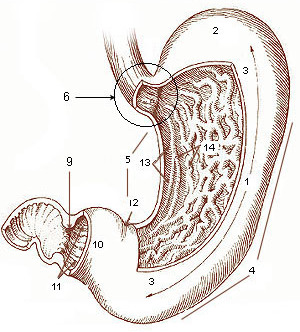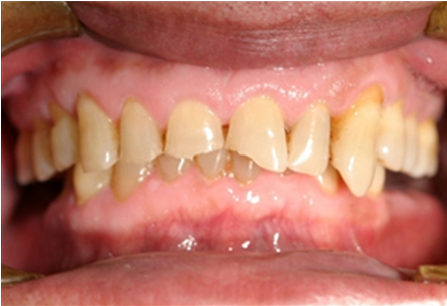|
Hyperchlorhydria
Hyperchlorhydria, sometimes called chlorhydria, sour stomach or acid stomach, refers to the state in the stomach where gastric acid levels are higher than the reference range. The combining forms of the name ('' chlor-'' + '' hydr-''), referring to chlorine and hydrogen, are the same as those in the name of hydrochloric acid, which is the active constituent of gastric acid. In humans, the normal pH is around 1 to 3, which varies throughout the day. The highest basal secretion levels are in the late evening (around 12 A.M. to 3 A.M.). Hyperchlorhydria is usually defined as having a pH less than 2. It has no negative consequences unless other conditions are also present such as gastroesophageal reflux disease (GERD). A cause for hyperchlorhydria is increased Gastrin production See also * Achlorhydria * Hypochlorhydria Achlorhydria and hypochlorhydria refer to states where the production of hydrochloric acid in gastric secretions of the stomach and other digestiv ... [...More Info...] [...Related Items...] OR: [Wikipedia] [Google] [Baidu] |
Stomach
The stomach is a muscular, hollow organ in the gastrointestinal tract of humans and many other animals, including several invertebrates. The stomach has a dilated structure and functions as a vital organ in the digestive system. The stomach is involved in the gastric phase of digestion, following chewing. It performs a chemical breakdown by means of enzymes and hydrochloric acid. In humans and many other animals, the stomach is located between the oesophagus and the small intestine. The stomach secretes digestive enzymes and gastric acid to aid in food digestion. The pyloric sphincter controls the passage of partially digested food ( chyme) from the stomach into the duodenum, where peristalsis takes over to move this through the rest of intestines. Structure In the human digestive system, the stomach lies between the oesophagus and the duodenum (the first part of the small intestine). It is in the left upper quadrant of the abdominal cavity. The top of the stomach lies ... [...More Info...] [...Related Items...] OR: [Wikipedia] [Google] [Baidu] |
Gastric Acid
Gastric acid, gastric juice, or stomach acid is a digestive fluid formed within the stomach lining. With a pH between 1 and 3, gastric acid plays a key role in digestion of proteins by activating digestive enzymes, which together break down the long chains of amino acids of proteins. Gastric acid is regulated in feedback systems to increase production when needed, such as after a meal. Other cells in the stomach produce bicarbonate, a base, to buffer the fluid, ensuring a regulated pH. These cells also produce mucus – a viscous barrier to prevent gastric acid from damaging the stomach. The pancreas further produces large amounts of bicarbonate and secretes bicarbonate through the pancreatic duct to the duodenum to neutralize gastric acid passing into the digestive tract. The active components of gastric acid are protons and chloride. Often simplistically described as hydrochloric acid, these species are produced by parietal cells in the gastric glands in the stomach ... [...More Info...] [...Related Items...] OR: [Wikipedia] [Google] [Baidu] |
Reference Range
In medicine and health-related fields, a reference range or reference interval is the range or the interval of values that is deemed normal for a physiological measurement in healthy persons (for example, the amount of creatinine in the blood, or the partial pressure of oxygen). It is a basis for comparison for a physician or other health professional to interpret a set of test results for a particular patient. Some important reference ranges in medicine are reference ranges for blood tests and reference ranges for urine tests. The standard definition of a reference range (usually referred to if not otherwise specified) originates in what is most prevalent in a reference group taken from the general (i.e. total) population. This is the general reference range. However, there are also ''optimal health ranges'' (ranges that appear to have the optimal health impact) and ranges for particular conditions or statuses (such as pregnancy reference ranges for hormone levels). Val ... [...More Info...] [...Related Items...] OR: [Wikipedia] [Google] [Baidu] |
Classical Compound
Neoclassical compounds are compound words composed from combining forms (which act as affixes or stems) derived from classical Latin or ancient Greek roots. New Latin comprises many such words and is a substantial component of the technical and scientific lexicon of English and other languages, via international scientific vocabulary (ISV). For example, ''bio-'' combines with '' -graphy'' to form ''biography'' ("life" + "writing/recording"). Source of international technical vocabulary Neoclassical compounds represent a significant source of Neo-Latin vocabulary. Moreover, since these words are composed from classical languages whose prestige is or was respected throughout the Western European culture, these words typically appear in many different languages. Their widespread use makes technical writing generally accessible to readers who may only have a smattering of the language in which it appears. Not all European languages have been equally receptive to neoclassical ... [...More Info...] [...Related Items...] OR: [Wikipedia] [Google] [Baidu] |
Hydro-
Hydro from Ancient Greek word ὕδωρ (húdōr), meaning ''water''. Hydro may also refer to: Energy technologies * Water-derived power or energy: ** Hydropower, derived from water ** Hydroelectricity, in electrical form * "Hydro", AC mains electricity in parts of Canada Utilities Australia * Snowy Hydro * Hydro Tasmania Canada * Canadian Hydro Developers (not specific to a province) * In Manitoba: ** Manitoba Hydro ** Winnipeg Hydro, Manitoba * In Ontario: ** Ontario Hydro ** Hydro One ** Hydro Ottawa ** Toronto Hydro * Specific to other provinces: ** BC Hydro, British Columbia ** Newfoundland and Labrador Hydro ** Hydro-Québec Europe * Norsk Hydro, in Norway * Scottish Hydro Electric Other uses * Hydro (fuel-station chain), in Sweden * SF ''Hydro'', former Norwegian railway ferry Places * Hydro, Oklahoma, United States * Hydro, Ontario, Canada Personal names * "Hydro", professional wrestler Jamar Shipman Buildings * Hydro, a term for ... [...More Info...] [...Related Items...] OR: [Wikipedia] [Google] [Baidu] |
Chlorine
Chlorine is a chemical element with the symbol Cl and atomic number 17. The second-lightest of the halogens, it appears between fluorine and bromine in the periodic table and its properties are mostly intermediate between them. Chlorine is a yellow-green gas at room temperature. It is an extremely reactive element and a strong oxidising agent: among the elements, it has the highest electron affinity and the third-highest electronegativity on the revised Pauling scale, behind only oxygen and fluorine. Chlorine played an important role in the experiments conducted by medieval alchemists, which commonly involved the heating of chloride salts like ammonium chloride ( sal ammoniac) and sodium chloride (common salt), producing various chemical substances containing chlorine such as hydrogen chloride, mercury(II) chloride (corrosive sublimate), and hydrochloric acid (in the form of ). However, the nature of free chlorine gas as a separate substance was only recognised ar ... [...More Info...] [...Related Items...] OR: [Wikipedia] [Google] [Baidu] |
Hydrogen
Hydrogen is the chemical element with the symbol H and atomic number 1. Hydrogen is the lightest element. At standard conditions hydrogen is a gas of diatomic molecules having the formula . It is colorless, odorless, tasteless, non-toxic, and highly combustible. Hydrogen is the most abundant chemical substance in the universe, constituting roughly 75% of all normal matter.However, most of the universe's mass is not in the form of baryons or chemical elements. See dark matter and dark energy. Stars such as the Sun are mainly composed of hydrogen in the plasma state. Most of the hydrogen on Earth exists in molecular forms such as water and organic compounds. For the most common isotope of hydrogen (symbol 1H) each atom has one proton, one electron, and no neutrons. In the early universe, the formation of protons, the nuclei of hydrogen, occurred during the first second after the Big Bang. The emergence of neutral hydrogen atoms throughout the universe occurre ... [...More Info...] [...Related Items...] OR: [Wikipedia] [Google] [Baidu] |
Hydrochloric Acid
Hydrochloric acid, also known as muriatic acid, is an aqueous solution of hydrogen chloride. It is a colorless solution with a distinctive pungent smell. It is classified as a strong acid. It is a component of the gastric acid in the digestive systems of most animal species, including humans. Hydrochloric acid is an important laboratory reagent and industrial chemical. History In the early tenth century, the Persian physician and alchemist Abu Bakr al-Razi ( 865–925, Latin: Rhazes) conducted experiments with sal ammoniac ( ammonium chloride) and vitriol (hydrated sulfates of various metals), which he distilled together, thus producing the gas hydrogen chloride. In doing so, al-Razi may have stumbled upon a primitive method for producing hydrochloric acid, as perhaps manifested in the following recipe from his ("The Book of Secrets"): However, it appears that in most of his experiments al-Razi disregarded the gaseous products, concentrating instead on the color c ... [...More Info...] [...Related Items...] OR: [Wikipedia] [Google] [Baidu] |
Active Ingredient
An active ingredient is any ingredient that provides biologically active or other direct effect in the diagnosis, cure, mitigation, treatment, or prevention of disease or to affect the structure or any function of the body of humans or animals. The similar terms active pharmaceutical ingredient (also abbreviated as API) and bulk active are also used in medicine, and the term active substance may be used for natural products. Some medication products may contain more than one active ingredient. The traditional word for the active pharmaceutical agent is pharmacon or pharmakon (from el, φάρμακον, adapted from ''pharmacos'') which originally denoted a magical substance or drug. The terms active constituent or active principle are often chosen when referring to the active substance of interest in a plant (such as salicylic acid in willow bark or arecoline in areca nuts), because the word "ingredient" in many minds connotes a sense of human agency (that is, something that ... [...More Info...] [...Related Items...] OR: [Wikipedia] [Google] [Baidu] |
Gastroesophageal Reflux Disease
Gastroesophageal reflux disease (GERD) or gastro-oesophageal reflux disease (GORD) is one of the upper gastrointestinal chronic diseases where stomach content persistently and regularly flows up into the esophagus, resulting in symptoms and/or complications. Symptoms include dental corrosion, dysphagia, heartburn, odynophagia, regurgitation, non-cardiac chest pain, extraesophageal symptoms such as chronic cough, hoarseness, reflux-induced laryngitis, or asthma. On the long term, and when not treated, complications such as esophagitis, esophageal stricture, and Barrett's esophagus may arise. Risk factors include obesity, pregnancy, smoking, hiatal hernia, and taking certain medications. Medications that may cause or worsen the disease include benzodiazepines, calcium channel blockers, tricyclic antidepressants, NSAIDs, and certain asthma medicines. Acid reflux is due to poor closure of the lower esophageal sphincter, which is at the junction between the stomach a ... [...More Info...] [...Related Items...] OR: [Wikipedia] [Google] [Baidu] |
Gastrin
Gastrin is a peptide hormone that stimulates secretion of gastric acid (HCl) by the parietal cells of the stomach and aids in gastric motility. It is released by G cells in the pyloric antrum of the stomach, duodenum, and the pancreas. Gastrin binds to cholecystokinin B receptors to stimulate the release of histamines in enterochromaffin-like cells, and it induces the insertion of K+/H+ ATPase pumps into the apical membrane of parietal cells (which in turn increases H+ release into the stomach cavity). Its release is stimulated by peptides in the lumen of the stomach. Physiology Genetics In humans, the ''GAS'' gene is located on the long arm of the seventeenth chromosome (17q21). Synthesis Gastrin is a linear peptide hormone produced by G cells of the duodenum and in the pyloric antrum of the stomach. It is secreted into the bloodstream. The encoded polypeptide is preprogastrin, which is cleaved by enzymes in posttranslational modification to produce progastrin (an intermed ... [...More Info...] [...Related Items...] OR: [Wikipedia] [Google] [Baidu] |


